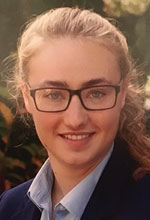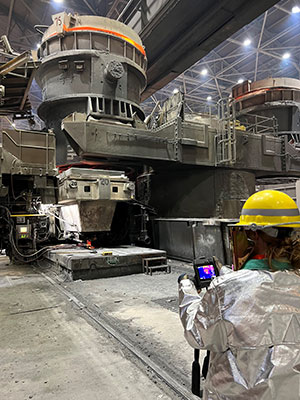AIST Foundation Steel Intern Scholarship - Willy Korf
 Lauren O. Jaracz
Lauren O. Jaracz
This summer I completed my second internship with the caster maintenance engineering team at Cleveland-Cliffs in Burns Harbor, Ind., USA. Throughout this internship I was exposed to so many great learning opportunities both relating and not relating to the steel making process. While this was my second internship at this location, I worked on projects that focused on completely different parts of the process, so it felt like an entirely different experience, while I also benefited from the knowledge I gained from the previous summer which has made this an even more meaningful experience.
I divided my time between project work, observing processes alongside maintenance work, and learning more about the casters and the steel making process. Although I was assigned to the casters, I also attended intern tours around each department in the plant to learn on a high level what we do at Burns Harbor and see what it really means to be the largest fully integrated steel mill.
 At the casters, I got to see firsthand and learn all about how molten steel is continuously cast into slabs that will then be processed into what a customer ordered. While that might sound simple and straightforward, it is not! One of the necessary components to the continuous casting process is the use of a tundish, which is usually described as a bathtub-like piece of equipment that works as an accumulator for molten steel. It is located underneath the ladle to hold and distribute steel into the mold, allowing for ladles to be swapped out without stopping cast. This was the primary focus of a few of my projects.
At the casters, I got to see firsthand and learn all about how molten steel is continuously cast into slabs that will then be processed into what a customer ordered. While that might sound simple and straightforward, it is not! One of the necessary components to the continuous casting process is the use of a tundish, which is usually described as a bathtub-like piece of equipment that works as an accumulator for molten steel. It is located underneath the ladle to hold and distribute steel into the mold, allowing for ladles to be swapped out without stopping cast. This was the primary focus of a few of my projects.
I completed a redesign and learned AutoCAD to create a drawing for the tundish form plugs, which are vital while pouring a refractory safety lining around the tundish form and into a newly refurbished tundish. Likewise, I redesigned and drew the tundish overflow chute form, which is a separate piece used in conjunction with the tundish form. These projects were particularly interesting to me as in my first internship at Cliffs I worked with a draftsman to document my designs, but this summer I was given the opportunity to do my own drafting which I thoroughly enjoyed. I also completed a lift plan to safely maneuver the tundish form in and out of the tundish.
In addition to the tundish projects, I got to support operations in information gathering for a few different investigations into rolls that would no longer turn that are utilized throughout the strand. This causes quality issues and so it is vital to catch these stuck rolls quickly and use preventative measures to avoid this altogether. To do this, I went to the machine shop and watched some rolls be taken apart to identify points of failure. Additionally, I got to look at a roll segment in a test stand to test the internal cooling systems to find a clogged hose preventing the cooling water from getting through. To try and get ahead of stuck rolls, I performed thermal imaging in the strand during a turnaround to try and identify rolls that were receiving insufficient cooling, which I think might have been my favorite part.
On top of these main projects I worked on other smaller projects and got to learn and experience so much more that have contributed to my development technically, professionally and personally. I am very thankful for this internship opportunity as well as the scholarship through AIST.
